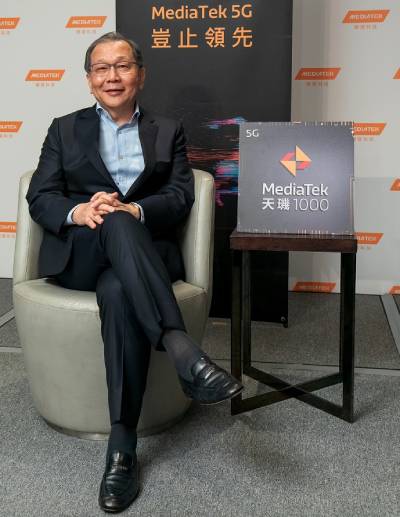MediaTek Announce 5G Modem Alliance with Intel
Article By : Alan Patterson

Competing with Qualcomm and Huawei, MediaTek introduces the first 5G smartphone chip to support dual SIM cards.
MediaTek has launched its new line of 5G chips for smartphones and formed an alliance with Intel, which will provide 5G modems for laptop computers.
The Taiwan-based chip designer announced Dimensity, a family of 5G SoCs to deliver connectivity, multimedia, AI and imaging for premium smartphones.
Dimensity 1000 is the first in the company’s 5G family of chipsets. The single chip, with an integrated 5G modem, is MediaTek’s first 7 nm product to compete with similar offerings from Huawei and Qualcomm. The Dimensity 1000 will be on the market later this year.
The MediaTek chip supports 5G two-carrier aggregation (2CC CA) and is the first to provide dual 5G SIM technology. MediaTek said the chip has the world’s fastest throughput with 4.7 Gbps downlink and 2.5 Gbps uplink speeds over sub-6GHz networks. The product also integrates the latest Wi-Fi 6 and Bluetooth 5.1+ standards for high-performance local wireless connectivity, offering more than 1 Gbps throughput in both downlink and uplink speeds, according to the company.
“Our Dimensity series is a culmination of MediaTek’s investment in 5G and positions us as a leader driving 5G development and innovation. Our 5G technology goes head-to-head with anyone in the industry,” MediaTek president Joe Chen said in a press statement.

Rick Tsai
The chip combines four Arm Cortex-A77 cores operating up to 2.6 GHz with four Arm Cortex-A55 cores operating at up to 2.0GHz for an optimal balance of high performance and power-efficiency, according to the company. The chipset also runs an Arm Mali-G77 GPU for streaming and gaming at 5G speeds.
The chip has a new MediaTek AI Processing Unit — APU 3.0 — with more than double the performance of the previous generation APU. Early benchmark scores indicate that Dimensity 1000 will reach an ETH score, the Zurich AI Benchmark, of 55,828. The chip is designed to support standalone and non-standalone (SA/NSA) sub-6 GHz networks, and includes multi-mode support for every cellular connectivity generation from 2G to 5G.
The Dimensity’s integrated 5G modem is a more power-efficient design than competing solutions, according to MediaTek. The compact, integrated design also allows smartphone brands extra space for other features like a bigger battery or larger camera sensors.
Even so, MediaTek will still be playing catch up with its 5G rivals, according to Tirias Research analyst Jim McGregor.
“They are a bit late to the party, but they are still ahead of Apple,” McGregor told EE Times.
“It is good that the modem will be integrated into the chip,” said McGregor. “Qualcomm will still have a discrete modem for its highest tier for the upcoming generation.”
The absence of mmWave support in the MediaTek chip will be good for China and other countries that are still working on a mmWave strategy, McGregor said. However, the chip won’t be as competitive in regions like the U.S., where carriers are rolling out mmWave solutions, he added.
MediaTek will target the chip for Chinese smartphone makers first, but the Taiwanese company — which counts China as its biggest market — already faces competition from Qualcomm and HiSilicon, and soon they will have UNISOC (formerly Spreadtrum) in the rear-view mirror, McGregor said. HiSilicon is willing to sell modems to handset vendors other than its parent company Huawei, he noted.
Intel alliance
In the meantime, MediaTek has entered into an alliance with Intel to provide 5G modems for use in laptop computers.
In August this year, Apple said it would pay about $1 billion to acquire Intel’s smartphone modem business, signaling that Apple aims to design its own silicon for 5G.
MediaTek is developing the 5G modem for Intel and working with partners to manufacture the silicon, the companies said in a press statement. TSMC is MediaTek’s main foundry partner.
Dell is expected to be among the first computer brands to deliver laptops powered by the Intel and MediaTek components. The first 5G laptops are expected by early 2021, according to the companies.
The new 5G modem for PCs is based in part on MediaTek’s Helio M70 5G modem introduced earlier this year as part of the company’s integrated 5G SoC.
“5G is poised to unleash a new level of computing and connectivity that will transform the way we interact with the world,” said Gregory Bryant, Intel executive vice president and general manager of the Client Computing Group. “Intel’s partnership with MediaTek brings together industry leaders with deep engineering, system integration and connectivity expertise to deliver 5G experiences on the next generation of the world’s best PCs.”
Analysts weigh in
The move found support from industry analysts.
“Intel doesn’t have a working 5G modem, and neither does Apple, so this move makes sense,” Arete Research senior analyst Brett Simpson told EE Times. “Qualcomm has been partnering with Microsoft on a dedicated 5G SoC for notebooks using Windows on Arm, so it would not make sense for Intel to partner with Qualcomm here.”
Intel remains a key technology driver for the PC market, according to Linley Group principal analyst Linley Gwennap. Cellular-enabled laptops currently account for less than 5% of the notebook market, but that portion could grow given the higher speed of 5G, he says.
The seeming contradiction of Intel selling its modem business and then partnering with MediaTek is not so contradictory when one considers the huge investment versus the return for Intel to develop and field a competitive 5G modem, according to VLSI Research CEO Dan Hutcheson. Intel turned around and partnered with MediaTek in order to have a complete reference design for Intel’s customers, he said.
“Having real-time internet connectivity has been a dream of laptop consumers for decades,” Hutcheson said. “The market has been there. One barrier has been that the PC and cellular providers could never come to terms.”
PC suppliers didn’t want to deal with the distribution costs and complexity of having different modems for different service providers. Service providers didn’t want to have their networks clogged up with the massive amounts of data that a PC can pump out, according to Hutcheson.
“The game has changed since then, as users now connect use their cell phones as WiFi hotspots, though it’s a pain to do this, Hutcheson told EE Times. “5G is the real game changer in terms of the data it can handle.”
Subscribe to Newsletter
Test Qr code text s ss


